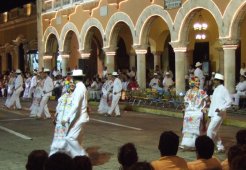
La Jarana is the typical dance of the Yucatan. It is danced to 3/4 or 6/8 timed music. In its strictest form, the dancers do not touch except an occasional hand hold. It is not a dance, but a style of dancing. The clothing used is typical of elegant yucatecan dress.
The city of Mérida has several weekly events where the jarana is highlighted. On Monday nights there is a show of just the jarana dance for an hour. We thought it was to start at 7:00, so we were downtown ready to go at that time. When we found out it did not start till 9:00, that put a damper on the evening. One of the ladies with our group had to take a few hundred pictures, so the wait did not seem that long. A little bit of ice cream helped pass the time as well.

After the festivities on the main square, we went to get my truck out of the parking garage. We got there and found out they closed at 9:00. I thought they closed at 10:00 or 10:30. Fortunately for us, there was a city worker going in to get a vehicle. This lot is used by the city. He took my money (and a bit extra) and said he would pay the parking lot in the morning for me. I think he probably will. Either way, I have my truck and I did not have to figure out which bus passes near my house.


